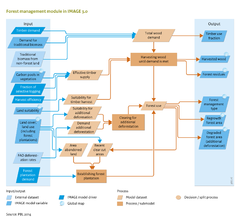Forest management/Description: Difference between revisions
Jump to navigation
Jump to search
Oostenrijr (talk | contribs) No edit summary |
No edit summary |
||
| Line 9: | Line 9: | ||
===Timber supply & production in forests=== | ===Timber supply & production in forests=== | ||
In IMAGE, felling in each region follows a stepwise procedure until timber demand is met, attributed to the three aforementioned management systems. The proportion for each management system is derived from forest inventories for different world regions ([[Arets et al., 2011]]) and used as model input (Figure Flowchart). Firstly, timber is | In IMAGE, felling in each region follows a stepwise procedure until timber demand is met, attributed to the three aforementioned management systems. The proportion for each management system is derived from forest inventories for different world regions ([[Arets et al., 2011]]) and used as model input (Figure Flowchart). Firstly, timber is derived from forests that have been converted to agriculture. Secondly, timber from forest plantations at the end of their rotation cycle are harvested. Finally, trees from natural forests are harvested, applying clear felling and/or selective felling. In all management systems, trees can only be harvested when the rotation cycle of forest regrowth has been completed. | ||
===Selective logging=== | ===Selective logging=== | ||
| Line 15: | Line 15: | ||
===Forest plantations=== | ===Forest plantations=== | ||
Forest plantations are established for efficient, commercially viable wood production. Their regional establishment in IMAGE 3 is scenario driven (see also Input/Output Table at [[Forest management|Introduction part]]), based on FAO. The expectation is that increasingly more wood will be produced in plantations because sustainability criteria may limit harvest from natural forests ([[Brown, 2000]]; [[Carle and Holmgren, 2008]]; [[FAO, 2012b]]) | Forest plantations are established for efficient, commercially viable wood production. Their regional establishment in IMAGE 3 is scenario driven (see also Input/Output Table at [[Forest management|Introduction part]]), based on FAO. The expectation is that increasingly more wood will be produced in plantations because sustainability criteria may limit harvest from natural forests ([[Brown, 2000]]; [[Carle and Holmgren, 2008]]; [[FAO, 2012b]]). Forest plantations are assumed to be established firstly on abandoned agricultural land. When sufficient abandoned land is not available, forest plantations are established on cleared forest areas. When a forest plantation has been established, the land cannot be used for other purposes or converted to natural vegetation until the tree rotation cycle has been completed. | ||
===Additional deforestation === | ===Additional deforestation === | ||
Revision as of 17:47, 2 November 2016
Parts of Forest management/Description
| Component is implemented in: |
| Components: |
| Related IMAGE components |
| Projects/Applications |
| Key publications |
| References |
